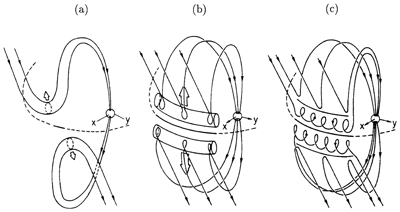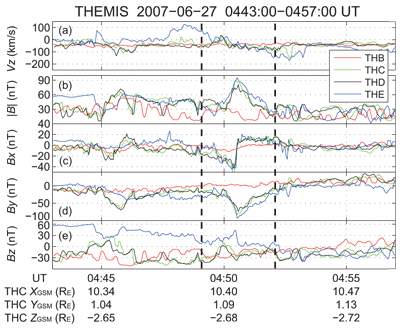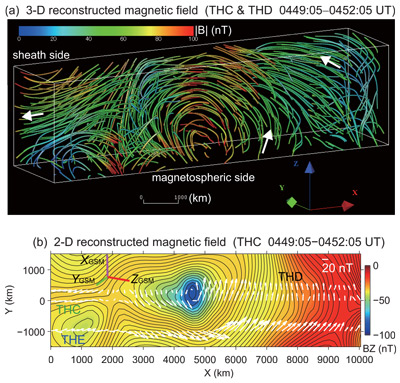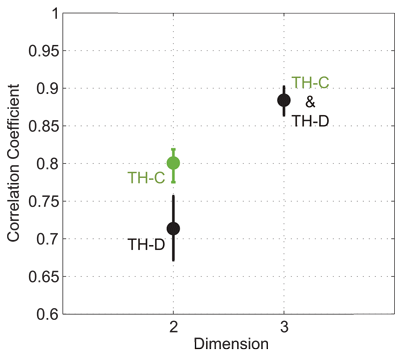
2015 THEMIS SCIENCE NUGGETS
Magnetopause Reconnection Generates a Three-Dimensional Magnetic Flux Rope
by Hiroshi Hasegawa
JAXA
Introduction
Magnetic reconnection plays a pivotal role in rapid release of magnetic energy in solar flares and magnetospheric substorms. It is believed to occur in the vicinity of black holes and neutron stars, and at the boundary between the heliosphere and interstellar space. This plasma process is known to occur at the outer boundary of Earth’s and planetary magnetospheres, called the magnetopause, and could play a dominant role in transport of solar wind mass, momentum, and energy into the magnetosphere.
| Figure 1. Three types of magnetopause reconnection and resultant formation of reconnected magnetic flux tubes or flux ropes, as viewed from north dusk (Paschmann et al., 2013). (a) Localized and transient reconnection, resulting in a pair of bent (three-dimensional) flux tubes, (b) extended and transient reconnection, resulting in structures elongated in a longitudinal direction, and (c) reconnection at multiple sites, resulting in magnetic flux ropes with helical field lines. |
Magnetopause reconnection often occurs in a non-steady and/or patchy fashion (Figure 1). Since the spatial and temporal nature of magnetopause reconnection is intimately related to the rate of energy and mass transfer across the boundary, it is important to understand the spatio-temporal properties of reconnection and resulting structures such as magnetic flux ropes. However, it is not easy to reveal those multi-dimensional properties from in situ measurements such as made by the THEMIS spacecraft. Thus we have developed a novel data analysis technique for the reconstruction of steady three-dimensional (3-D) magnetic field and plasma structures from two-spacecraft measurements. Here we briefly report results from the first application of the 3-D reconstruction method to THEMIS observations at the Earth's subsolar magnetopause.
| Figure 2.THEMIS observations of a magnetic flux rope at the subsolar magnetopause. (a) North-south component of the ion bulk velocity, (b), magnetic field magnitude, and (c-e) three GSM components of the magnetic field, seen by four of the five THEMIS probes. The bottom labels show the GSM location of the TH-C probe. The flux rope interval, sandwiched between the two thick dashed lines, was preceded by a northward reconnection jet (at ~04:48 UT) and was followed by a southward jet (at ~0453 UT), both seen by the TH-C and TH-E probes. |
Results
On July 27th 2007, four of the THEMIS probes encountered a magnetic flux rope at the dayside magnetopause under a southward interplanetary magnetic field condition. It manifests in time series of data as negative-then-positive variations of the Bx component (Figure 2c) and a peak in the magnetic field magnitude (Figure 2b) at ~04:50 UT. Interestingly, this flux rope was sandwiched between oppositely directed reconnection jets, one directed northward and one directed southward (Figure 2a), and turned out to have resulted from magnetopause reconnection at multiple sites.
| Figure 3.(a) 3-D structure of the flux rope reconstructed from the TH-C and TH-D (dual-spacecraft) observations. The white arrows show approximate orientations of the field lines, and colors show the field intensity reconstructed. (b) Two-dimensional (2-D) structure of the flux rope reconstructed from the TH-C (single-spacecraft) observation. The white arrows show the magnetic fields measured by TH-C, TH-D, and TH-E, projected onto the reconstruction X-Y plane, and colors show the out-of-plane field component. |
The 3-D magnetic field structure was reconstructed from the TH-C and TH-D data (Figure 3a). It shows that the observed flux rope had a diameter of ~3000 km. The 2-D reconstruction result (Figure 3b) shows that the recovered field lines are not parallel to the magnetic field vectors measured by the TH-E probe, suggesting that the 2-D assumption is violated in this flux rope. Indeed, a quantitative comparison (Figure 4) demonstrates that the 3-D reconstruction better predicts the field variations along the TH-E path than the 2-D reconstruction, indicating that the flux rope observed in this particular event has a significant 3-D structure.
| Figure 4.Correlation between the magnetic field components actually measured by the TH-E probe and those predicted at points along the TH-E path from the reconstructed fields as shown in Figure 3. The 3-D reconstruction (Figure 3a) better predicts the field variations at TH-E than the 2-D reconstruction (Figure 3b). |
Conclusion
We conclude that magnetic reconnection at the subsolar magnetopause can occur in a 3-D manner, thus creating a 3-D flux rope as observed. Figure 4 also shows that the performance of the 3-D reconstruction technique is sufficiently good in predicting the field variations around the paths of the two spacecraft that provided the initial conditions. In 3-D reconnection, reconnected field lines can interact in a complex way, possibly affecting the rate of energy transfer across the magnetopause and the partition of magnetic energy released through reconnection. In the coming years, Magnetospheric Multiscale (MMS), four identical spacecraft successfully launched on March 12, 2015, will conduct very high spatio-temporal resolution measurements of particles and electromagnetic field for ultimate understanding of magnetic reconnection. We hope that the 3-D field from our 3-D reconstruction method will provide a large-scale context for in-depth analysis of the MMS data and eventually help reveal the role of 3-D reconstruction. .
Reference
Hasegawa, H., B. U. O. Sonnerup, S. Eriksson, T. K. M. Nakamura, and H. Kawano (2015), Dual-spacecraft reconstruction of a three-dimensional magnetic flux rope at the Earth's magnetopause, Ann. Geophys., 33, 169-184, doi:10.5194/angeo-33-169-2015.Biographical Note
Hiroshi Hasegawa is an assistant professor at the Institute of Space and Astronautical Science of Japan Aerospace Exploration Agency (JAXA). His research focuses on transport of solar wind mass and energy across the magnetopause and into the magnetosphere, and reconstruction of multi-dimensional structures from in-situ spacecraft measurements.
 Please send comments/suggestions to
Emmanuel Masongsong / emasongsong @ igpp.ucla.edu
Please send comments/suggestions to
Emmanuel Masongsong / emasongsong @ igpp.ucla.edu




